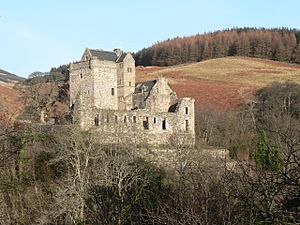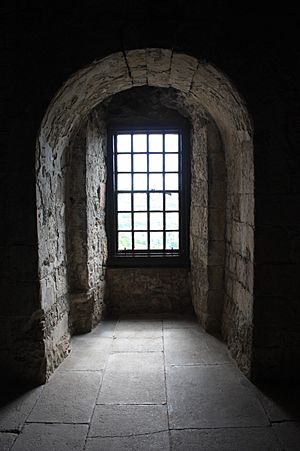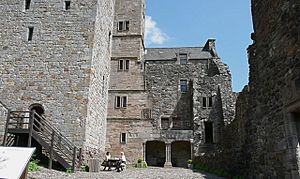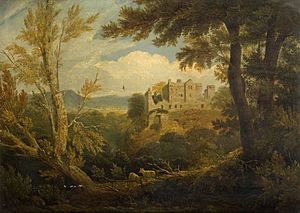Castle Campbell facts for kids
Castle Campbell is an old castle in central Scotland. It stands high above the town of Dollar, Clackmannanshire. This castle was the main home for the powerful Campbell family for many years. They were the chiefs of Clan Campbell from the 1400s to the 1800s. Even Mary, Queen of Scots, visited it in the 1500s. She liked it so much she said it reminded her of home!
History of Castle Campbell
Castle Campbell was first called Castle Gloom. This name might have come from a word meaning 'chasm'. It referred to the deep, narrow valleys around the castle. The castle's location was naturally protected. The main tower you see today was built around 1430.
Around 1460, a powerful leader named Colin Campbell, 1st Earl of Argyll got the castle. He married Isabel Stewart, who was related to the previous owner. The first official mention of the castle was in 1461. That year, Pope Paul II sent a special message. It was against Walter Stewart for attacking and damaging "Place of Glom." Colin Campbell was at the Pope's court at the time. He might have helped get the Pope involved. The tower shows signs of being rebuilt after this attack.
| Castle Campbell Act 1489 | |
|---|---|
| Act of Parliament | |
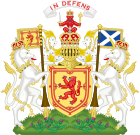
|
|
| Long title | The castell callit the Gloume to be callit in tyme tocum Campbele. |
| Citation | February 1489 c. 23 |
| Dates | |
| Royal assent | 3 February 1489 |
Getting Castle Gloom helped the Campbell family become even more powerful. Their influence spread from Argyll in the west to central Scotland. This was also good for Colin Campbell. He was in charge of the King's household. This job meant he had to be at court often.
In February 1490, Campbell asked the new King, James IV of Scotland, to officially change the castle's name. The King agreed, and it became "Castle Campbell." This was done by a special law called the Castle Campbell Act 1489. Changing the name might mean that "castle" was a very important title. It needed royal approval to be used.
At this time, the castle had the main tower house. There were also other buildings around a courtyard and gardens. The east side of the castle was probably built first. Later, after 1493, a large south section was started. These new buildings looked like parts of Stirling Castle. This section included a grand hall and bedrooms. They had big windows facing south. These windows looked out over the gardens and the Devon Valley. This part of the castle also had more private rooms. You could reach them by two stairways.
The 1500s at the Castle
In the 1500s, Archibald Campbell, 4th Earl of Argyll became a leader in the Scottish Reformation. This was a time of big changes in religion in Scotland. His family supported the Protestant preacher John Knox. Knox visited Castle Campbell and preached there in 1556.
In January 1563, Mary, Queen of Scots, stayed at Castle Campbell for three days. She was there for a wedding. It was the wedding of Margaret, sister to the Archibald Campbell, 5th Earl of Argyll. She married James Stewart, 1st Lord Doune. The celebrations included a special play with people dressed as shepherds. They played musical instruments called lutes. John Knox, however, did not like the dancing. Knox came back to Castle Campbell in February 1564. He met with the Earl of Argyll again.
There was a story that the Earl of Moray and the Earl of Argyll planned something. They wanted to capture Queen Mary and Lord Darnley. This was in July 1565. Mary and Darnley were riding back to Edinburgh from Perth. The plan was to imprison Mary at Lochleven Castle or St Andrews Castle. Darnley would be taken to Castle Campbell. This was to stop their marriage. After Mary and Darnley did marry in 1565, Argyll joined a rebellion. It was called the Chaseabout Raid. Mary and Darnley later took control of Castle Campbell.
Colin Campbell, 6th Earl of Argyll and his wife Agnes Keith had many beautiful tapestries. In 1584, they used 18 of them to decorate the castle. In the more peaceful 1590s, Archibald Campbell, 7th Earl of Argyll, rebuilt the east side of the castle. This connected the south part with new guest rooms in the tower. The new part had a lovely two-arched walkway facing the courtyard. It was made of smooth, polished stone. Behind this were long hallways. These were popular additions to castles at the time. There were also new stairs. An inventory from 1595 listed all the furniture and decorations. It showed there were 47 beds in the castle!
In 1590, James VI of Scotland was unhappy with the castle's captain. He had let a prisoner escape. The prisoner was found guilty of serious crimes. He was given a horse to get away. Also, Agnes Douglas, Countess of Argyll held a man in the castle. She claimed he was stealing sheep.
Castle Destruction and Later Years
The Earls of Argyll continued to support the Protestant side. In the mid-1600s, Archibald Campbell, 8th Earl of Argyll, became a leader of the Covenanters. They were against the Royalists, led by James Graham, 1st Marquess of Montrose. In 1645, Montrose's soldiers were on their way to a battle. They destroyed the lands around Castle Campbell. This included the towns of Dollar and Muckhart. Many of Montrose's men were from Clan Maclean. This clan had been enemies of the Campbells for a long time. The castle itself was not damaged. No attack was made on it. In return, Argyll ordered the destruction of Menstrie Castle and Airthrie Castle. These were homes of Royalist supporters.
After King Charles I was executed, the Campbells first supported Charles II. Argyll even placed the crown of Scotland on Charles' head in 1651. However, Argyll did not agree with Charles' plan to invade England. In 1652, he joined Oliver Cromwell's Commonwealth. Cromwell's soldiers were stationed in Castle Campbell in 1653. In July 1654, Royalist rebels attacked and burned Castle Campbell. It burned for two nights.
Argyll was executed after the King was brought back to power in 1660. His son, the 9th Earl, built a new home in Stirling. He did not rebuild Castle Campbell. The castle was used briefly by soldiers in 1715. After that, it was left empty.
In 1805, the 6th Duke of Argyll sold the castle. It was bought by Crauford Tait. In 1859, a businessman named Sir Andrew Orr bought the castle. His son, James Orr, had people dig at the castle in the 1870s. They found pieces of stained glass from the windows.
In 1948, the owners gave the land around the castle to the National Trust for Scotland. They arranged for the castle to be looked after by the government. Restoration work has included putting a new roof on the tower. Digs in the 1980s found burned wood from the 1654 fire. Today, Historic Environment Scotland manages the castle. It is a protected historic site.


